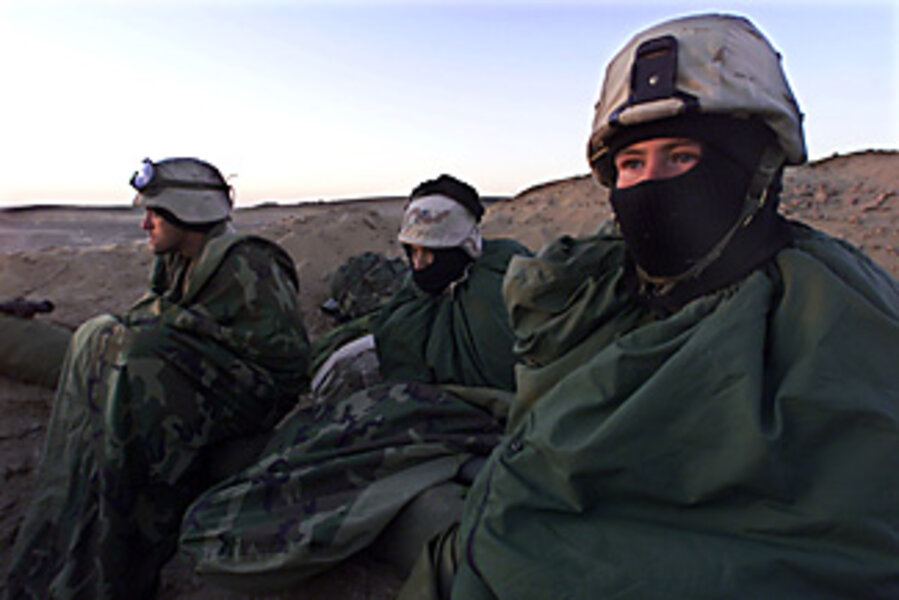Enough U.S. help for Afghanistan?
Loading...
| Washington
When 3,200 US marines deploy to Afghanistan this spring, the message it sends is that the US remains committed to the security of the country and its future. But the deteriorating situation there won't turn around until the United States makes changes that recognize the mission's strategic and symbolic importance and raise Afghanistan from "forgotten war" status, analysts and a senior retired officer say.
Defense Secretary Robert Gates had opposed sending more US forces to the NATO-led mission in Afghanistan, but he reluctantly conceded after failing to get a greater contribution from allies, many of whom say they have little more to give.
But the marines destined for Afghanistan are on a one-time, seven-month deployment that fills a gap only for trainers and combat forces, say analysts. They won't supply the kind of counterinsurgency that country needs, they say.
That would require more resources, a more effective organizational structure for NATO, and smarter thinking about how to strengthen Afghanistan's political and economic systems, says one retired senior officer. It also would probably mean a greater commitment of US troops, perhaps thousands more.
"If we're going to be ahead of the insurgency, then you have to have a substantial-sized force," says a retired senior officer who didn't want to be named due to the political sensitivities of the matter.
A new focus in Afghanistan for the US should also include an "empowered US ambassador" overseeing the nonmilitary efforts – akin to the role of Ambassador Ryan Crocker in Iraq – even as American military forces, still under NATO command, conduct a counterinsurgency where it's needed, says the retired officer.
Perspectives on counterinsurgency
Some 50,000 total forces are currently in Afghanistan, about half of them American. Half of those American forces fall under a subordinate US command that oversees the country's eastern region, where an effective counterinsurgency is being waged, say many analysts in the US. It is in the southern region, including Helmand and Kandahar Provinces, where Dutch, Canadian, and British troops predominate, where a broader new strategy is most needed, they say.
Pentagon strategists are reportedly refining a review of Afghanistan, which will be discussed during a meeting of NATO ministers in Europe this winter. Deteriorating security in Afghanistan, which has seen more suicide bombings and rising violence over the past year, has also piqued the interest of Congress: The House Armed Services Committee on Wednesday will entertain ideas for changing strategy.
The US had employed a proper counterinsurgency strategy in Afghanistan, but it began to falter after the 2005 announcement that NATO would take over the mission, argued David Barno, a retired Army three-star general, in an article last fall in the Army periodical Military Review.
"Unsurprisingly, this was widely viewed in the region as the first signal that the United States was 'moving for the exits,' thus reinforcing long-held doubts about the prospects of sustained American commitment," wrote Mr. Barno, who will testify Wednesday before the House panel. The US must revive a counterinsurgency strategy in Afghanistan, he said.
In a separate development that could shape the future of Afghanistan and NATO, Army Gen. David Petraeus, the top US commander in Iraq and the man credited with creating an effective counterinsurgency strategy there, is being considered for command of NATO later this year, The New York Times reported on its website Sunday.
Unwieldy command structure?
One crucial move is to refine the complex organizational structure for the NATO force, with its bifurcated commands and complex command-and-control relationships.
"If there is an overhaul needed, it is getting a unity of command," says Jim Phillips, a research fellow at the Heritage Foundation, a conservative think tank here. "Unfortunately, the military effort is disjointed, with so many different NATO forces pursuing different strategies."
Secretary Gates, however, has already decided not to push for changes to the organizational structure of the mission, after members of the Joint Staff last year recommended no change. "They ... recommended that we leave it as it is, and that is my intent," Gates said Thursday.
A proper counterinsurgency would include more attention to political, economic, and other nonmilitary issues, some say. Abdullah Abdullah, a former minister of foreign affairs for Afghanistan, said at a Washington think tank on Friday that part of what Afghanistan needs is help strengthening trust between Afghans and their central and provincial governments.
"If the US doesn't make some extra efforts to enable the government ... to gain the trust of the people, this will weaken any military strategy," he said.
Education for all Afghans is the ultimate "prerequisite for strategic success," says Paul McHale, assistant secretary of Defense for homeland defense. Mr. McHale wore a different hat last year, taking leave from his Pentagon job and deploying as a reserve officer to help develop the Afghan National police. He says bolstering education initiatives, opening schools, and giving girls more opportunities to learn will help the country to turn the page.
The military fight will set the conditions for success, but it's not the only thing, says McHale. "Trigger-pulling will not win this war," he says.





